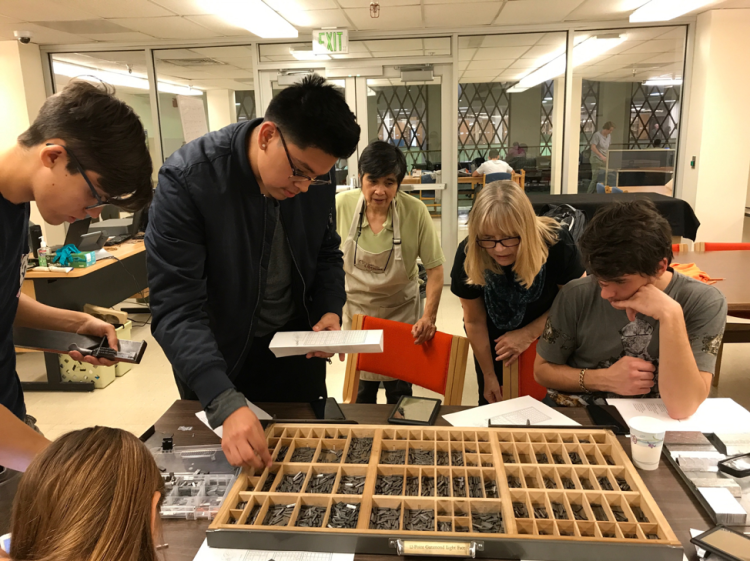Students make rhyme and reason of the Periodic Table
In ‘Poetic Table of the Elements,’ students of Danny Long combine art and science, old and new
Who could refrain, that had a periodic poem to write, and in that poem, courage to make an element known (apologies to Shakespeare).

From bottom left to right, Sara Nebreda Perez, Michael Gonzales, Gabe Raymondi, Julia Seko, Susan Guinn-Chipman and Arsen Bassenov work to typeset student poems by hand as part of Danny Long's class. At the top of the page, a poem is typeset; the text is backwards so that it will print correctly. Photos by Sarah Schleifer.
Students of Danny Long’s Radical Science Writing class (WRTG 3030) have the poem to write and the courage to make it happen, and the final project will be displayed on a giant Poetic Table of the Elements later this year in the University of Colorado Boulder’s Norlin Library.
Long’s students are getting a hands-on lesson in attention to detail with their latest project in which they compose, typeset and hand-print 118 poems for the elements of the Periodic Table.
The goal of the poem itself is to “teach a little kernel of information” about each element, whether that be the etymology of its name, discovery or function. “My students write about so many different things and yet never have we even talked about the periodic table as a form of writing, as a way of communicating science,” Long explains, citing it as an “untapped resource.”
With the help of Gregory Robl and Susan Guinn-Chipman of the Special Collections, Archives, and Preservation Department and Julia Seko of Scholarly Resource Development, students learned to handset and print the type using techniques that encourage “mindfulness,” as one of Long's students, Sara Nebreda Perez, observed.
“So much of what we do on campus anymore is intangible, and so maybe there’s something about just getting to sit down and create things by hand,” Long says of this project, which requires the slow and deliberate setting of tiny metal letters—upside down and backwards—into “furniture” that holds it in place to be printed.
These poem cards will be mounted onto a 5 ½-foot-tall x 10-foot-wide Poetic Table of the Elements and displayed at the University Libraries with the help of Andrew Violet of the Administration Department, with additional copies going to Special Collections and the staff and students involved. There are also plans to sell one copy to another institution through Vamp and Tramp booksellers.
By Ryan Henley
The Russian-named number 44,
A metal found in platinum ore.
Found sparsely in the Ural range,
I cost a hefty hunk of change.
Tin—50
By DiemMy Nguyen
Mix me with copper, you’ll surely get bronze.
Those so-called tin cans? Well, they are all cons.
I cry when I’m bent, but I am still strong.
Coat metals with me, and they will last long.
Manganese—25
By Jason DesVeaux
Alone I am weak,
but with others I shine:
To bodies, bones, and metals
I am divine.
Long, an instructor in the Program for Writing and Rhetoric at CU Boulder, says he likes incorporating creative projects into his science-writing class and that students also respond well to his self-proclaimed “radical” syllabus. Past projects of his include children’s books to teach first graders math and science.
Robl, who helps students set their type and print their poems, calls this project, which mixes science writing, poetry and traditional typesetting, “pretty radical on many levels for instruction for undergraduates” and, also, “just too cool.”
Long says some unexpected benefits of this project were the in-depth discussions he had with his students about grammar and punctuation. Talking about everything from the rhetorical effects of different punctuation to sentence structure while “focusing in on a really small piece of writing” was a productive way to look analytically at these mechanisms and “get a lot of punch out of it.”
He calls the Poetic Table assignment a good metaphor for the “radical” course name. The term “radical” is “often used to describe something that’s extreme, but it also comes from the Latin word meaning ‘root,’” Long says. In addition to describing something new and unusual, he notes, it also describes something old.
He agrees that it’s an apt way of looking at his class, which examines “the history of scientific communication and plays around with old forms of communication in slightly new ways.” The Poetic Table combines an old example of scientific communication that’s been developing over several centuries with a contemporary poetic twist.
“It’s been fun listening to the students explain to me why they wrote what they wrote.” Long quips that “usually it goes over my head because I’m not a scientist,” but says the amount of research and effort the students put into their poems is “encouraging and inspiring.”

